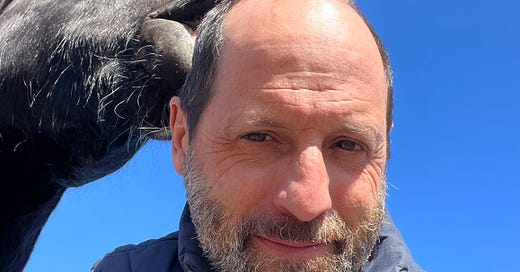Horses study humans, and probably more than we study them. How do I know this? Sometimes when I visit Hunter while he is in the barn, he will make vocal sounds before he sees me, calling me to greet him. He can hear me talking with others outside his field of view. When I am working with clients, Hunter and Romeo will stand perfectly still without a lead line attached, listening to the class. And best of all……a horse will give me a hug when I most need it. Basically, a horse will wrap its neck around my head and pull me into their body. It is a powerful and unmistakable gesture. It does not happen often, but it always happens when I need it the most.
I am a human who likes to study horses and their behaviors. I observe them in their environments and look for ways to improve their day-to-day life. They more we become curious, the more they reciprocate.
Galloway, who I like to call the ‘Gentle Giant,’ shares a paddock with Hunter. They are best friends. Two senior Citizens (capital ‘C’ to emphasize their important role with the herd) look after each other, and advocate for each other.
Yesterday, I went to visit Hunter in his paddock to give him a Chi massage. This is a very simple technique that I learned from a Tunia Chinese massage therapist. This style of massage helps the horses with joint issues and releasing tension.
Hunter started to walk away after a few minutes of touch. I followed him. He walked next to Galloway and stopped. He directed me to Galloway! Hunter was concerned about his friend! He was giving me instructions to give a Chi massage to Galloway, not him.
WHAT??!!!!??
We know horses are sensitive, they have many emotions, and they have strong social bonds. Once you begin to accept this view, a whole new world will emerge. And the horses will thank you.
Galloway, whose exact age is unknown (same as Hunter and many horses), is in his early twenties. His owner provides excellent care for him, and rescued him from a sales farm. She thinks he may have been a foal from a pharmaceutical factory that collects the urine of pregnant mares for the drug production of Premarin. The mares are kept in small standing stalls in order to limit their movement, so as not to displace the urinary bladder bags used to collect every drop of urine. Premarin is a hormone replacement therapy drug for humans. The foals are ‘disposable.’
Like many horses, Galloway loves touch. I know exactly where he likes touch and where he is holding tension, only because I take the time to ask him for his feedback. After I give him a ten-minute Chi massage, I stand next to him and let him absorb the information. He looks at me and then starts to nuzzle my ear. He is a big draft horse and can be intimidating if you don’t know him.
I receive his gift while standing still. He puts his chin on top of my head, and tries to take my hat off. Because I like my hat, I take it off for him.
This is when I understand his message. He grooms the top of my head. He uses his lips and his teeth, like a masterful painter, while he massages my head. He uses his teeth to stimulate the skin, while his lips are massaging the surface and moving the Chi (a simple translation is “life force").
He does this for maybe five minutes. This is not the first time he performed this healing act. He did this a few months ago while working with him in the indoor arena. In my world view, there are no accidents. Everything happens for a reason. I have struggled in the past with over ten head and neck injuries. I had to seek alternative therapies which helped me recover.
Galloway probably could have saved me many hours of searching and living in pain if I knew his gift.
How did he know where to focus his attention?
Could he sense the history of head injuries?
Can he sense past trauma?
Is this what horses are doing when they give each other ‘buddy scratches’ and massage each other?
Or is it simply a gesture of gratitude that I gave him a massage?
You may or may not agree, but there is something much deeper going on. There are multiple studies how horses help reduce stress and anxiety for humans. Horses, in general, are much more present, hence why they are good clinical researchers and practitioners.
When Galloway is finished, I thank him. I thank Hunter for his guidance. As I close the gate to their paddock, I feel the joy of such an enormous gift.
If you would like to know more about Equine Guided Learning programs for children or Horse-Human Connect programs for adults, contact me at cam@camronadibi.com
All my posts are free. If you become a paid subscriber or a founding member, you will help the care of the horses and help make the programs affordable for children.
Camron Adibi is an Equine Human Connection Therapist and a PATH Therapeutic Riding Instructor who holds graduate degrees in education and architecture. He offers Equine Guided Learning for children and adults of all backgrounds and ages, who are facing challenges such as anxiety, depression, trauma, or emotional/social difficulties. He also offers ‘Listening with the Herd,’ as an invitation to explore sound, movement and breathing with horses. He has a mission to improve horse and human interactions through education and storytelling. Oh yeah, and Cam is a sailor with a captain's license. www.camronadibi.com





Yes, my friend, there is , indeed, something much deeper going on...
Thank you for sharing